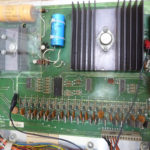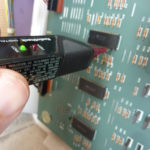Prior to starting, read the section on using a Digital Logic Probe. While a great deal of troubleshooting can be down without the logic probe, having one makes this much easier. They are inexpensive and far easier to use than most people realize.
Bally Lamp Board ’76 – ’85
This system uses a lamp board that Bally (and Stern) used from ~1976 to ~1985 including Eight Ball, Eight Ball Deluxe, Silverball Mania, Mata Hari, Strikes & Spares, 6 Million Dollar Man, etc. It is a pretty basic system.
Note: This board does not work with LED’s unless modifications are made. See using LEDs on Bally / Stern boards.
 When a single lamp does not work on this pin, most will just slap in a new transistor / SCR. It usually fixes the problem, but not always. Pulling out your digital logic probe takes only a few seconds and will check your suspicion. Besides, it is a great way to practice.
When a single lamp does not work on this pin, most will just slap in a new transistor / SCR. It usually fixes the problem, but not always. Pulling out your digital logic probe takes only a few seconds and will check your suspicion. Besides, it is a great way to practice.
Prior to proceeding, look at the drawing for a SCR above, and understand which lead is the anode, cathode and gate.

The image shows the circuit for the Bally lamps (click for larger image). The 5.4 VDC is applied to all the switched lamps, goes through the bulb then to the lamp board. A SCR (works like a transistor) shorts the circuit to ground and turns on the lamp. The SCR is controlled from the output of U2 (a decoder chip).
In this case, the bulb below the “I” insert on the playfield, does not work. Prior troubleshooting, you have already shorted the wire at the connector J1-1 to ground to see that the lamp comes on (or you should not be doing this!). That proves that the power is available to run the lamp, the bulb and socket are good and the wiring is working.
If the bulb is locked on, it is also worthwhile testing to insure that it is a shorted SCR prior to replacing.
Hooking up the Probe

See “Using the Probe“, above. Turn the power off to the pin. There is a convenient TP (test point) marked “GND” (ground) on the Driver Board. TP1 is +5V DC. Note that there is dangerous high voltage nearby that may run 200 volts or more.
Turn on and boot the pin. Press the button inside the coin door to enter the service menu. All controlled lamps will flash. Touch the probe to the top lead of Q29 (A), which is the Gate of the SCR. The probe should react with the flashing lights. If it does, the SCR is almost certainly defective. We can assume it is defective, because the SCR is receiving the signal to turn on, and it is not turning on.
Prior to replacing the SCR, it is a good idea to test continuity from the anode of the SCR to the plug pin coming into your transistor under test (in this example, J1-1). Also check to be certain that the cathode is grounded. This can be done with the probe. Touch it to the Anode of the SCR. It should be red (high). Test the other lead. It should read green (low). Note in this case it is safe to test the input from the lamp since it is in the safe operating range of the probe. But in solenoid / motor circuits, this check would destroy the probe.
If no pulsing at the gate of Q29 (A), move onto (B) R29. If pulsing there, then there is a broken trace / solder between R29 and Q29.

No pulse? Move onto the other side of R29 (C). If the probe pulses, then R29 is defective or there is a bad solder point.
No pulse? Move onto the IC (D) U2 pin 11. If there is a pulse there, suspect a broken trace or bad solder between there and R29? No pulse and this is the only light not operating? Suspect U2 as defective.
U2 is one of those ‘magic’ decoder chips. See the Decoder Chip section. Check other outputs at pins 4 – 11 and 13 – 20. Also check to insure that R29 is not shorted. A bad resistor can make it appear like the decoder chip is defective.
Note that it is easy to have the probe slip and hit two legs of the IC at the same time. Usually this is not going to cause a problem, but it is best to avoid this.
Bally Lamp Board Test Procedure

Bulb is not flashing during the lamp test. A “Yes” below means pulse on the probe; or a flip from high to low, or low to high. Click on ‘Bally Lamp Board showing test locations‘ photo above, for test points.
1) Test at (A). – Yes = replace SCR (Q) – No = move to (B)
2) Test at (B) – Yes = bad trace or solder R29 to Q29 – No = move to (C)
3) Test at (C) – Yes = bad R29 or solder – No = move to (D)
4) Test at (D) – Yes = bad trace or solder U2 to R29 – No = Bad U2 (see decoder ICs).